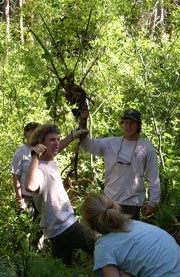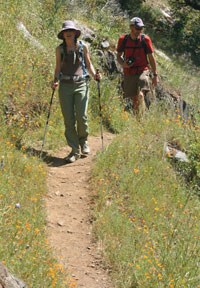|
Yosemite National Park’s environment is healthy in many ways, yet Yosemite can be affected by environmental issues. Some of these, like climate change, are especially challenging because they originate outside the park. The list below documents how Yosemite scientists approach some of these issues. Research and StudiesOngoing scientific research abounds at Yosemite, from declining animal species studies and invasive plant removal strategies to human carrying capacity issues. Yosemite's Division of Resources Management and Science, frequently hosts scientific symposiums for the public and other scientific presentations which are presented at monthly forums. In addition, the division processes hundreds of research permits every year for its staff and outside interests. 
Invasive SpeciesInvasive species have a negative impact on natural resources nationwide, including in Yosemite National Park. Non-native animal species, like the New Zealand mud snail, concern park scientists because this species can completely cover a river streambed, thereby altering the ecosystem. Plant species, like Himalayan blackberry, can form impenetrable thickets that replace native vegetation. Park botanists work to detect and prevent invasive plants, also referred to as noxious weeds, that cause ecological or economic damage. It is much easier to prevent the spread of invasive species than to try to eradicate them once they are introduced. Climate ChangeGlobal climate change is impacting Yosemite. Worldwide emissions of greenhouse gases trap heat in the atmosphere, leading to rapid warming observed across the western US. Scientists project that average temperatures in the park may rise by 6.7–10.3°F between 2000 and 2100. This trend is already impacting glaciers, snowpack, waterfalls, wildfire activity, forest health, and ecosystems throughout the park. As we witness shifts in natural systems, park scientists are working to document and understand these changes to support ongoing management decisions. Ultimately, climate change challenges us to consider what it means to conserve a place during a time of large-scale environmental change. SoundscapeThe acoustic environment of any area is made up of natural and human sounds. Cultural and historic sounds, like the rhythm of a horse-drawn wagon, are components, too. Sounds are an integral part of visitors' Yosemite experience. Listening to water flow or wildlife vocalize can be degraded by inappropriate sounds or sound levels. It's possible that increased noise may disrupt wildlife behavior, particularly in mating, locating prey, and complex communication methods. For these reasons, the unique enjoyment of sounds in a national park setting makes the soundscape worthy of protection. Dark Night SkyA natural lightscape, such as a dark night sky, is an environment that has not been disturbed by light or air pollution. In Yosemite, dark night skies have natural, cultural, and scenic importance. Animals, especially nocturnal ones, depend on darkness to hunt, conceal their location, navigate, and reproduce. Plants can be affected by artificial light because it disrupts their natural cycles. Many Yosemite visitors come to experience this worldwide vanishing resource. To study the topic, the National Park Service devised a system to measure sky brightness, and even remote parks like Yosemite face stray light pollution, particularly from the San Joaquin Valley. Scenic VistasLooking out from Yosemite's Inspiration Point offers a breath-taking scenic view. Views like this one, seen by explorers like James Mason Hutchings and John Muir, are part of the history that inspired the protection of the park in the late 1800s. Restoration projects prevent unnatural growth-vegetation encroachment-in open areas to retain the historic views for which Yosemite is known. Yosemite scientists aim to restore the park's historic scenic vistas using sound cultural and ecological practices and processes. A new multi-year project will identify historic and current park vistas using previous vista studies, historical records, GIS data, and site visits. The park's goal is to incorporate viewshed and vista management into applicable planning efforts. FireFire has many faces. It is a phenomenon that is both fascinating and dangerous. In Yosemite, it is something that we manage carefully and continue to learn more about. Yosemite has an extensive fire history. Historically, fire was often seen as a negative force, but in recent years it has been realized that the benefits of fire in forests are numerous. Yosemite's fire management program is designed to protect life, property, and natural and cultural resources, while ensuring the continuation of fire as a natural process. Fire managers use three tools to mimic fire's natural function in the ecosystem: prescribed fire, mechanical thinning, and wildland fire use. While visiting Yosemite, you may see evidence of any of these practices. 
Visitor UseSocial scientists conduct research to inform visitor use management, resource impact monitoring, and planning-related projects. A focus is put on the human dimensions of resources management, including the visitor experience. These components to effective park management encompass the documentation of existing-use conditions and associated resource impacts. Examples of research include correlating entrance station traffic volumes to crowding/congestion at attraction sites, and understanding how crowding affects travel time on the Half Dome cables. Also see general park statistics to learn how visitors use the park. Air QualityAir pollution is currently recognized as one of the most significant threats to the resources of the Sierra Nevada. Sources are local, regional, and in some instances, global. The National Park Service, in cooperation with state and other federal agencies, is making concerted efforts to reduce the damage caused by air pollution. This is done by an intensive monitoring program, by offering support for research, and by expanding the education of park visitors concerned about the future of Yosemite National Park Weather and ClimateYosemite National Park is a changing environment where weather can vary by the minute, with increased chances of change at higher elevations. Temperatures at the 4,000-foot Yosemite Valley can rise to more than 100°F in the summer with lows in the 20s and nearly 30 inches of snowfall, on average. Lightning, common in the summer, is an essential element in the Sierra Nevada fire-dependent environment. Since 1972, lightning ignited 1,800 fires in Yosemite; a third of those were managed by park staff. Overall, the changing weather only adds to the enjoyment of Yosemite, luring visitors during all four seasons.
Learn More
|
Last updated: August 22, 2023
